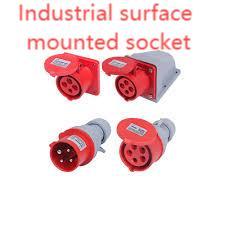Choosing the right Industrial surface mounted socket at the design stage avoids expensive on-site rework, and specifying the correct Industrial surface mounted socket helps coordinate mounting, sealing, and maintenance access so installations remain reliable over decades. Early collaboration between design, installation, and maintenance teams creates clearer expectations for load types, ingress protection, mounting substrates, and spare-part strategies that directly affect long-term performance and total cost of ownership.
Site and substrate evaluation
A useful specification begins with a rigorous site survey. Document the substrate material—concrete, timber, composite cladding, or thin-sheet metal—and assess likely mechanical impacts, vibration sources, pedestrian or vehicle traffic, and exposure to cleaning regimes or chemical sprays. Each substrate requires different backing plates, anchor methods, and through-fastening strategies. Include thermal cycling and UV exposure in the survey; environments that cycle between hot and cold demand different gasket compounds and mounting allowances than stable indoor-outdoor transitions.
Material selection and corrosion resilience
Material choices determine lifespan. For coastal or chemically aggressive sites, choose stainless-steel enclosures with matched fastener metallurgy to prevent galvanic corrosion. For lighter applications, specify UV-stable engineering polymers with reinforced ribs and tested impact resistance. Surface pretreatment and high-quality powder coatings extend protective life more than topcoat selection alone. Internally, choose plated terminals and corrosion-resistant screws; these small choices maintain contact integrity and reduce the frequency of service interventions.
Sealing, cable entry design, and strain relief
A weatherproof enclosure is only as good as its cable entries. Use removable gland plates and partitioned entries so future additions won't require cutting new holes. Select elastomers compatible with expected chemical exposure and temperature ranges; replaceable gasket channels simplify future maintenance. Proper strain relief prevents conductor tugging that can compromise seal compression. For multi-cable installations, plan partitioned routes to avoid seal pooling and maintain uniform compression across the flange.
Nante modular options and upgrade paths
Modularity reduces lifecycle disruption. Choose enclosure families that accept removable inserts—power blocks, surge modules, and communications interfaces—so upgrades can be completed without breaching the main sealing faces. Nante’s modular line offers standardized mounting rails, front-access terminal trays, and pre-tested gland modules that speed installation and simplify stocking of spare inserts. Factory-validated assemblies reduce commissioning surprises and allow teams to pre-assemble complex configurations before site deployment.
Installation, commissioning, and documentation practices
Even a robust product can be undermined by poor installation. Use a commissioning checklist that verifies gasket seating, confirms torque values at terminal blocks, and validates gland compression. Record installation parameters—gland types, torque settings, orientation, and backbox depth—so later service replicates the original conditions. Where practical, perform a controlled spray verification after installation to confirm ingress resistance. Maintain complete as-built documentation and include photos of cable entries and mounting details for future troubleshooting.
Thermal layout, segregation, and surge protection
Plan internal layouts to isolate heat-generating equipment from sensitive electronics. Provide thermal spreaders or conductive mounting for high-dissipation components. Reserve space for surge protective devices and ensure their location does not impede gasket compression or maintenance access. Maintain physical segregation between power and control wiring to reduce interference and simplify future diagnostics.
Maintenance planning and spare-part strategy
Create a spare-part kit containing common gaskets, gland plates, captive fasteners, and replaceable inserts to minimize mean time to repair. Standardize on a limited set of components across multiple sites to simplify logistics. Schedule periodic inspections focused on seal compression, terminal discoloration, and fastener security. Use thermal imaging during scheduled maintenance to detect high-resistance contacts before they fail.
Supplier validation and procurement safeguards
Require suppliers to provide IP/IK test reports, material declarations, and witnessed assembly certificates. Prefer vendors who offer configurators and pre-validated assemblies that show expected temperature rise under typical loads. Batch traceability and clear installation instructions make warranty claims and audits straightforward. Transparent lead times and documented test evidence reduce procurement risk.
Balancing upfront cost and lifecycle value
Assess total cost of ownership rather than unit price. Consider maintenance intervals, spare-part lead times, warranty support, and supplier responsiveness. A slightly higher initial investment in tested seals, compatible fasteners, and modular options often yields lower lifetime costs and reduced operational disruption.
Selecting the right industrial surface-mounted socket family—one tailored to substrate, environment, and upgrade expectations—ensures reliable, maintainable power distribution. For product families, detailed datasheets, and configurators, visit www.nante.com
